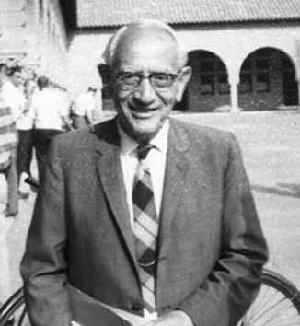The Universal Language of Problem-Solving
Ever had one of those 'Aha!' moments in the shower? You know, when a solution to a problem you've been mulling over suddenly becomes crystal clear? Now, imagine if there was a method to get to that 'Aha!' moment, every single time. Enter George Polya, the genius who gave us just that—a universal approach to problem-solving.
In the vast world of mathematics, where numbers dance and equations sing, George Polya stands out not just as a mathematician, but as a visionary. While his peers were diving deep into complex theorems, Polya was zooming out, observing a pattern. He noticed that behind every great solution was a structured approach—a method. And this wasn't just about math. It was about life, business, tech, and everything in between.
Did you know? Polya wasn't just a theorist. He was a passionate educator, teaching at Stanford University. He believed in the power of understanding, often saying, "If you can't solve a problem, then there is an easier problem you can solve: find it."
This method, which we'll dive into, isn't just for those who dream in numbers. Whether you're a software developer trying to debug a pesky piece of code, a startup founder looking for market fit, or just someone trying to figure out the fastest route to work, Polya's got your back.
Let's unravel the magic of Polya's method—a tool that's as relevant today in Silicon Valley as it was in 20th-century classrooms.
The Genesis of Polya's Method
Picture this: It's the early 20th century. Jazz is all the rage, Einstein's making waves with his theory of relativity, and in a classroom somewhere in Europe, George Polya is having an epiphany.
While many of his contemporaries were lost in the abstract beauty of mathematics, Polya was a tad different. He was obsessed with the 'how' of things. How do we approach problems? How do we find solutions? And most importantly, how can we teach others to do the same?
It wasn't just a fleeting thought. Polya noticed a recurring pattern among his students at Stanford University. Many were brilliant, no doubt, but they often hit roadblocks, not because they lacked knowledge, but because they lacked a structured approach to unfamiliar challenges. They were like skilled sailors lost at sea without a compass.
Drawing from his years of teaching and research, Polya began formulating a method—a universal approach to problem-solving. This wasn't about fancy theorems or complex equations. It was about thinking, systematically. In 1945, he introduced the world to this method in his groundbreaking book, "How to Solve It."
Fun Fact: "How to Solve It" wasn't just a hit among mathematicians. It was lauded by educators, scientists, and thinkers across the board. Even the legendary physicist, Richard Feynman, was known to sing its praises!
In the book, Polya outlined a four-step approach:
- Understand the Problem: Dive deep, ask questions, and grasp the essence.
- Devise a Plan: Strategize. Think of similar problems you've tackled before.
- Carry Out the Plan: Execute with precision. If one approach doesn't work, pivot.
- Look Back: Reflect. Analyze. Learn.
It sounds simple, right? But its beauty lies in its universality. Whether you're cracking a mathematical conundrum, optimizing an algorithm, or planning a marketing strategy, Polya's method lights the way
Interviews with Polya's Method
Okay, real talk. Interviews? I suck. Every time I see a LeetCode question, my brain goes full 'SpongeBob SquarePants' mode and screams, 'I'm ready... I'm ready... I'm not ready!' But here's a thought: What if there's a way to tackle this? Why shouldn't Polya's method work with interviewing? Let's break it down.
Understanding the Problem: The first hurdle in any interview is understanding what's being asked. And I'll be honest, I often find myself re-reading questions multiple times, trying to figure out what the question is asking, almost like trying to figure out why the Golden State Warriors blew a 3-1 lead in the 2016 NBA Finals. But here's where Polya's first step might come in handy. Instead of panicking, take a step back, read the question slowly, and maybe even paraphrase it. Understanding is half the battle, right? After all, clarity is the first step to genius, isn't it?
Devising a Plan: Once the question is somewhat deciphered, the real panic sets in. Instead of methodically planning an approach, I'm like Rickon Stark running straight against Ramsay Bolton's arrows—predictable and doomed. I'm blindly hoping something comes together. But what if, instead of this haphazard approach, we just take a moment to draft a rough blueprint? Or ponder similar previous challenges that might share some similarities? Polya's method might just be the lifeline to transition from wild guesswork to a structured strategy.
Executing the Plan: With a clearer strategy in mind, coding might just become a tad less daunting. Polya's third step is all about execution. And while fumbling and making mistakes is likely, having a plan could provide a roadmap, a guide through the coding process.
Reviewing: This is something I rarely do. It's like a post-game interview from Marshawn Lynch for me. But Polya's fourth step emphasizes its importance. Once the code is written, review it. Test it against different scenarios. Reflect on the approach. Could it be more efficient? This step might be the difference between a 'good' solution and a 'great' one.
The Hope: Look, I'm not saying Polya's method is a magic wand that'll instantly make interviews a breeze. But it offers a structured approach, a potential lifeline in those nerve-wracking moments. And as I embark on this journey to get better at interviewing, I'm hopeful that Polya's steps might just be the guide I need.

